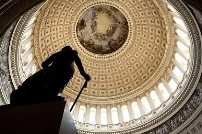
Big Data’s Evolving Role in Government Economic Policy
The potential impact of big data on individual business has been well documented, in this publication and others. Companies have figured out how to leverage big data sets toward specific goals, such as increasing sales, detecting fraud, and hundreds of other uses. But when it comes to applying big data in the fields of economics and public policy, the fields are pretty green.
Today, there is no shortage of economic data sources to tap into. The question is whether the public policy makers and the private contractors that work for them can harness that data in an effective way that improves the livelihoods of Americans (and hopefully reduces risk along the way).
Earlier this year, two Stanford University and NBER researchers, Liran Einav and Jonathan Levin, put their best big data feet forward when they published a paper titled “The Data Revolution and Economic Analysis.”
Levin and Einav acknowledge that the federal government already collects massive sums of data through various programs including the Social Security Administration, the Internal Revenue Service, and the Centers for Medicare and Medicaid. There’s also a lot of data being collected at the state and local levels, especially in education, social insurance, and local government spending, although it has less uniformity, they say.

These data sets contain a treasure trove of information. It’s particularly useful because of its “universal” nature and broad applicability. For example, an analysis of IRS data has demonstrated a widening of an “income gap” in recent years. Similarly, researchers looking at Medicare claim data have discovered a troubling variability in per-enrollee spending that is taken as evidence of inefficiency in the US healthcare system.
These types of insights are valuable to policy makers and add real meat to public discussion on these topics. However, just getting to the data in the first place can be hard, because it’s stored in individual silos controlled by separate administrations, Einav and Levin says. As a result, government data is underutilized, both by public policymakers and private researchers alike. However, projects like Data.gov, the online clearinghouse of federal data, will make the data much more available to private and public researchers alike.
In the future, Einav and Levin see a potential for public policymakers to make greater use of privately sourced big data sets.
For example, measures of inflation could be garnered by using data from the Billion Prices Project (BPP), which pulls data from hundreds of online retail websites in more than fifty countries. Currently, inflation figure are gathered manually by the Bureau of Labor Statistics, which sends people out to stores to get prices on 80,000 items, and aggregates it into the Consumer Price Index (CPI). The BPP and CPI measures seem to move together, Einav and Levin note.
Other private sources that might be valuable to government economists include MasterCard and Visa, which track spending, and ADP and Moody’s Analytics, which track employment numbers. But care must be taken not to apply these privately sourced data sets so broadly that they exceed their statistical usefulness, Einav and Levin warn. “They are essentially ‘convenience samples’ and may not be entirely representative,” they write. “On the other hand, the data are available at high frequency and granularity.”
Policymakers may also tap Web searches for clues about economic indicators. Einav and Levin note that Google search engine data has shown to provide “accurate proxy measures of economic time series such as unemployment claims and consumer confidence.” To date, the researchers note that there haven’t been any studies showing correlation between Twitter posts and underlying macroeconomic realities or shopping trends, “but one can easily imagine how these types of high-frequency data would complement, and perhaps eventually substitute, more traditional (and lower frequency) data series on economic activity,” they write.
The government is free to collect all sorts of information. But where rubber meets the road is what the government does with all the information. This is a tricky area, and the government must walk carefully. Few rational Americans have a problem with the Federal Reserve pushing interest rates up or down and tightening or easing the monetary supply, based on any available data they can get. But as big data is more broadly adopted, privacy concerns will be have to be addressed, especially considering PRISM and other controversial government surveillance programs.
Consider the potential for utilize advanced data analytics in government healthcare programs. For example, Medicare could “score individuals based on their likely response to a treatment and cover the treatment only if the score exceeded a particular level.” A similar approach could be used for forecasting the efficacy of a tax rebate program designed to provide economic stimulus, the researchers note.
These forecasting applications would probably work. After all, companies in the private sector do similar things every day. But it would never fly in the public sphere, Levin and Einav say. “Of course, we tolerate this in the private sector, but many people’s reaction to parallel approaches taken by the government would be horror,” the researchers write.
While there are challenges to overcome in the use of big data in the public sphere, it’s undoubtedly a worthwhile path to take.
“There is little doubt, at least in our own minds, that over the next decades ‘big data’ will change the landscape of economic policy and economic research,” the researchers conclude. “We don’t think that big data will substitute for common sense, economic theory, or the need for careful research designs. Rather, it will complement them. How exactly remains to be seen.”
Related Items:
Reducing Suicide Rates with Predictive Analytics
The Intersection of Public Policy and Big Data
Big Government, Big Data, Big Savings?































